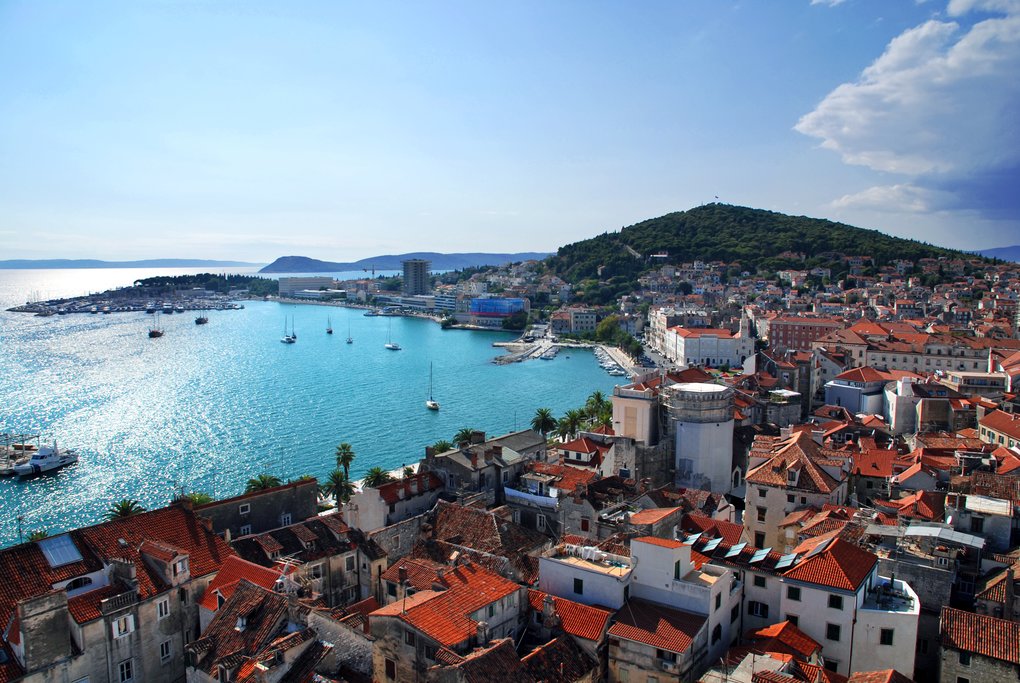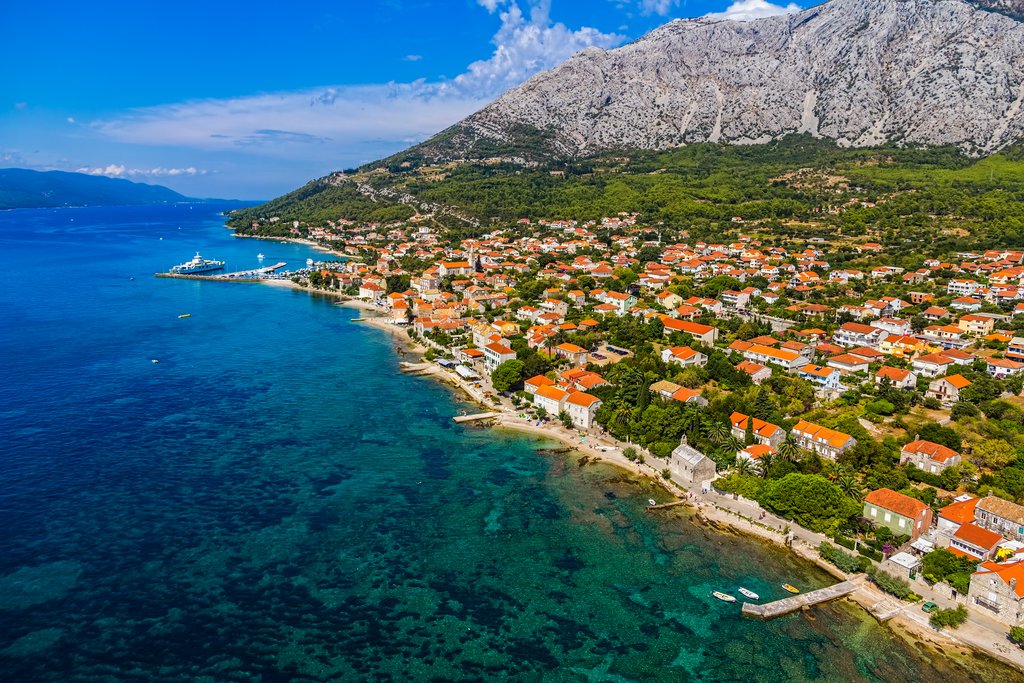Highlights
- View Split from atop Marjan Hill and learn about its 1700-year-old Roman history
- Hike through sweetly scented lavender fields on Hvar
- Walk the Napoleon path on the island of Korčula
- Discover Ston's impressive defensive wall in the Pelješac peninsula
- Explore the marble streets and baroque buildings of Dubrovnik's Old Town
Brief Itinerary
| Day | Highlights | Overnight |
|---|---|---|
| Day 1 | Welcome to Split! | Split |
| Day 2 | Ferry from Split to Brač, Coastal Beach Walk | Brač Island |
| Day 3 | Ferry from Brač to Hvar, Hike the Lavender Road | Hvar Town |
| Day 4 | Ferry from Hvar to Korčula | Korčula Town |
| Day 5 | Hike through the Forests and Vineyards of Korčula | Korčula Town |
| Day 6 | Hike through Pelješac Peninsula | Dubrovnik |
| Day 7 | Depart Dubrovnik |
Detailed Itinerary
Day 1: Welcome to Split!

From the airport, it's a short (45-minute) drive to the center of Split. Depending on your arrival time, check into your hotel and take the rest of the day to explore the historic port city on your own.
Founded 1,700 years ago by Roman emperor Diocletian, Split's Old Town consists of a number of impressive sites, including Peristyle, Cathedral of St. Dominus, and Diocletian's Palace, one of the best-preserved Roman buildings in the world. Start in Peristyle Square, taking in the 3,500-year-old sphinxes Diocletian brought back from Egypt before exploring the 4th-century complex. From there, pass through the Iron Gate and into Pjaca Square for pretty views of white marble tiles, a Romanesque clock tower with the remains of a medieval sundial, and the 15th-century Town Hall.
In the evening, take a stroll along Split's seafront Riva to admire the waterfront views before finding the off-beat Konoba Dioklecijan restaurant, just to the left of the Bronze Gate for a bite to eat, its outdoor terrace built into the walls of Diocletian's Palace.
Day 2: Ferry from Split to Brač, Coastal Beach Walk

After breakfast, board a ferry to Supetar on the north side of Brač and check into your hotel before stretching your legs and spending some time exploring the island.
The largest of the central Dalmatian islands, Brač is bursting with historic sites dating back to ancient Greece and the Middle Ages. Brač is also famous for its stone sculptures and quarries, which were used in the construction of Diocletian's Palace and the White House in Washington, D.C.
Today you have a couple of options to choose from, either the longer walk to the west side of the island or the easier eastern coastal walk:
West Side Loop: 5 hours, 623 feet (190 m) elevation gain
Follow this 10 mile (16 km) loop through olive groves and between centuries-old stone fences, passing by vineyards until you reach Sutivan—a charming sleepy village on the north shore of Brač—before returning back to Supetar.
Eastern Coastline: 3 hours, 492 feet (150 m) elevation gain
This shorter, more gentle walk, covers 6.8 miles (11 km) and takes you along a path eastward, following the northern coastline to Splitska. This route features many beautiful beaches and plenty of opportunities to enjoy a quick dip in the Adriatic!
Ferry time (Split to Supetar): 1 hour
Day 3: Ferry from Brač to Hvar, Hike the Lavender Road

Catch a ferry to the island of Hvar for a day of trekking the Lavender Road. A Croatian island in the Adriatic Sea, Hvar is a popular destination with tourists due to its natural setting, mild climate, and its historic port town of the same name. Highlights of Hvar town include its 13th-century walls, a hilltop fortress, and the main square anchored by the Renaissance-era Cathedral.
Take the early afternoon to walk along the narrow streets of one of Europe's oldest towns, Stari Grad. Founded in the 4th century BCE, it was one of the first Greek colonies in the Adriatic. Explore its many charming squares and old stone buildings before continuing the 7-mile (12 km) trek to the southern coastline and Hvar Town.
Along the way, you'll hike through sweetly scented lavender fields and pass by gnarled olive groves before reaching the inland villages of Velo Grablje and Malo Grablje. Velo Grablje was once home to a thriving lavender industry and is slowly undergoing a revival. Today, only a few people inhabit the village throughout the year, but many gather for the annual lavender festival.
From here, follow an old trail—the main thoroughfare in medieval times connecting the north and the south of the island—to the village of Malo Grablje. Enjoy a delicious meal at perhaps the most authentic of the island's taverns before carrying on the gravel road to discover secluded beaches as you make your way to Hvar Town. After the day's adventures, treat yourself to a drink in the town's ancient piazza that overlooks the Venetian loggia, 7th-century fortification walls, and the oldest municipal theater in Europe.
Ferry time (Supetar to Stari Grad): 2.5-3 hours
Hiking time: 3-4 hours
Chat with a local specialist who can help organize your trip.
Day 4: Ferry from Hvar to Korčula

Collect your things and catch a ferry to Korčula. Once on Korčula, the afternoon and evening are yours to discover this little island's numerous restaurants, taverns, shops, and bars as you roam the maze of gray stone houses, alleys, churches, and squares.
Enjoy a traditional lunch of lamb and goat in Korčula's Old Town, one of the finest examples of Venetian architecture on the Dalmatian coast. Next, visit the 14th-century Land Gate on top of an elegant staircase, before heading to the St. Mark's Cathedral to admire its strange sculptures of beasts and people. Art enthusiasts will appreciate a visit to the Bishop's Treasury next door for a small but impressive art collection, including works from Carpaccio, Bassano, and Tiepolo. From there, you may wish to visit the unremarkable house thought to be the birthplace of Marco Polo.
If beaches are what you're after, rent a bike or ride the bus the 5 miles (8 km) to the sandy beaches of Lumbarda. Afterward, grab a bite to eat and pair it with the local dry white, Grk, indigenous to Lumbarda and nowhere else.
Ferry time (Hvar to Korčula): 1.5 hours
Day 5: Hike through the Forests and Vineyards of Korčula

Today, you'll explore Korčula by foot and hike through a nature park full of amazing karst rock formations, dense forest, and wildlife. The walk is peaceful and leisurely and will take you to the ancient Napoleon path along olive groves, small vineyards, and beautiful fields of sage, oregano, and other local herbs. End your hike in the village of Pupnat where a traditional local lunch has been prepared with ingredients from the fields you've just walked through.
After lunch, make your way back to medieval Korčula Town to explore the cobblestone streets, whitewashed buildings, and Gothic and Renaissance architectural masterpieces. Or spend the rest of the day enjoying the beach and water, paddleboarding, swimming, or relaxing on the sand.
Hiking distance: 7-14 miles (11-23 km)
Day 6: Hike through Pelješac Peninsula

Start the morning early with a short boat ride to the 15th-century maritime town of Orebić on the Pelješac Peninsula. From Orebić, you'll pass by charming stone villas, once occupied by famous sea captains, as you start your hike out of the town. You'll trek along the southern slopes of Mt. Ilija, passing remote vineyards and an old Franciscan monastery.
Along the way, stop to enjoy great vistas of nearby Korčula and the Pelješac archipelago before continuing your hike to the coast and along the waterfront to explore the laid-back Dalmatian villages, Kučište and Viganj.
Later this afternoon, you will make your way to Dubrovnik on the mainland. En route, you will stop in Ston to explore one of the longest defensive stone walls in Europe (originally built to keep predators away from the town's saltpans) and discover the importance this area held in the 14th century. Discover beautiful views over Ston and its glittering saltpans from a parapet walkway on Ston's wall. Reward your efforts with a light meal of fresh oysters or mussels before transferring overland to Dubrovnik.
Often referred to as the "Pearl of the Adriatic", Dubrovnik is a world-renowned city of exceptional charm. The remainder of the day will be at your leisure, allowing time for you to wander and explore this magical city. Climb the 16th-century city walls for incredible views of countless red rooftops of old stone houses, towers, turrets, churches, and palaces. And be sure to find your way to the limestone-paved Stradun, Dubrovnik's main street to get your bearings and choose from some of Croatia's best restaurants and wine bars.
Hiking distance: 2.5-6 miles (4-9.7 km) depending on route
Hiking time: 2 hours (optional Ston wall walk: 1 hour)
Day 7: Depart Dubrovnik

Depending on when you depart, you may have time to visit one of Dubrovnik's museums, like the Franciscan Monastery and Museum. This large complex houses many treasures, including the world's third oldest pharmacy dating from 1317.
Alternatively, for a collection of 15,000 pieces of interesting works, visit the Rector's Palace and Cultural Historical Museum. Wander this well-preserved palace-turned-museum and explore its exhibits, some detailing life in the Republic of Ragusa during medieval times.
The drive to the airport from Dubrovnik takes around 45 minutes with normal traffic.
